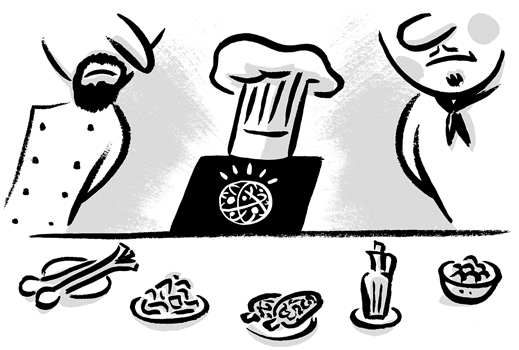If it sounds like a salad created by a computer, that’s because it is. “Morel Mushrooms Leek Katsuobushi Hazelnut Pear Poached” is the recipe that Florian Pinel, lead engineer at the IBM Watson Group, and I came up with (well, mostly Pinel did). To make it we used a beta version of an online extension of the new cookbook Cognitive Cooking with Chef Watson. This online engine, powered by IBM’s Jeopardy!-beating cognitive computing system Watson, allows you to “discover” a recipe by selecting a few key ingredients and then exploring other foods with similar “flavor compounds” in a matchmaking exercise similar to Pandora’s method of grouping musical acts by common traits. You can choose to pair the initially chosen foods with those it identifies or substitute one for another.

Pinel, a chef as well as a researcher, had the idea of pairing a spring classic, the morel mushroom, with Japanese bonito fish flakes (katsuobushi), two foods that share a surprising number of common flavors—120 altogether, according to Watson. Using a Western approach—Westerners like recipes consisting of ingredients with shared flavor compounds, while Eastern cuisines pair opposites—Watson then suggested other ingredients that it predicted would taste good with morels and fish flakes, including leek, hazelnut, and pear. Watson then searched its memory banks of the 10,000 recipes published by Bon Appétit magazine over the past decades to suggest a suitable preparation, a twist on a classic poached pear and blue cheese salad.
To test Watson’s culinary imagination, I went shopping, printout in hand. I had trouble finding morels—springtime comes late to Boston—but the fish flakes were easily located in the international aisle at Whole Foods. For the white wine in the dressing I chose a white Bordeaux. In the kitchen, I found Watson’s cooking directions to be a bit sparse and sometimes odd (1¼ heads of lettuce, for example), so I did some independent research: I consulted Martha Stewart for how long it takes to poach a pear (20 minutes) and Epicurious for directions on toasting hazelnuts. But overall, the recipe came together nicely, and the panel of taste testers (my family) liked the combination of crunchy nuts and sweet pear. The katsuobushi’s flavor was subtle, and I would recommend going light on the Parmesan, but overall I’d give a strong review to a chef who’ll never have the pleasure of tasting one of his own creations.
Don’t settle for half the story.
Get paywall-free access to technology news for the here and now.